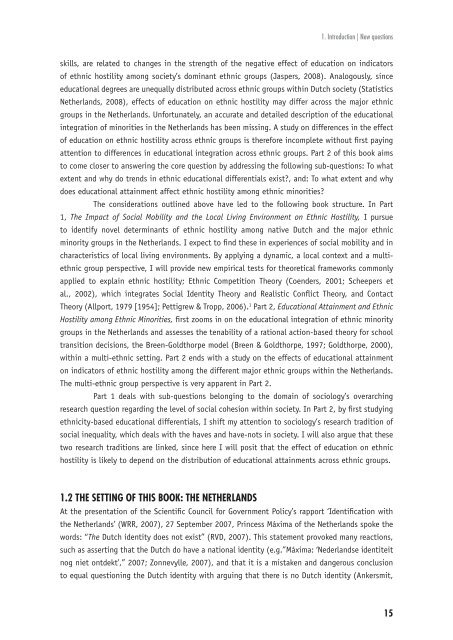Ethnic Hostility among Ethnic Majority and Minority Groups
Ethnic Hostility among Ethnic Majority and Minority Groups
Ethnic Hostility among Ethnic Majority and Minority Groups
You also want an ePaper? Increase the reach of your titles
YUMPU automatically turns print PDFs into web optimized ePapers that Google loves.
1. Introduction | New questions<br />
skills, are related to changes in the strength of the negative effect of education on indicators<br />
of ethnic hostility <strong>among</strong> society’s dominant ethnic groups (Jaspers, 2008). Analogously, since<br />
educational degrees are unequally distributed across ethnic groups within Dutch society (Statistics<br />
Netherl<strong>and</strong>s, 2008), effects of education on ethnic hostility may differ across the major ethnic<br />
groups in the Netherl<strong>and</strong>s. Unfortunately, an accurate <strong>and</strong> detailed description of the educational<br />
integration of minorities in the Netherl<strong>and</strong>s has been missing. A study on differences in the effect<br />
of education on ethnic hostility across ethnic groups is therefore incomplete without fi rst paying<br />
attention to differences in educational integration across ethnic groups. Part 2 of this book aims<br />
to come closer to answering the core question by addressing the following sub-questions: To what<br />
extent <strong>and</strong> why do trends in ethnic educational differentials exist?, <strong>and</strong>: To what extent <strong>and</strong> why<br />
does educational attainment affect ethnic hostility <strong>among</strong> ethnic minorities?<br />
The considerations outlined above have led to the following book structure. In Part<br />
1, The Impact of Social Mobility <strong>and</strong> the Local Living Environment on <strong>Ethnic</strong> <strong>Hostility</strong>, I pursue<br />
to identify novel determinants of ethnic hostility <strong>among</strong> native Dutch <strong>and</strong> the major ethnic<br />
minority groups in the Netherl<strong>and</strong>s. I expect to fi nd these in experiences of social mobility <strong>and</strong> in<br />
characteristics of local living environments. By applying a dynamic, a local context <strong>and</strong> a multiethnic<br />
group perspective, I will provide new empirical tests for theoretical frameworks commonly<br />
applied to explain ethnic hostility; <strong>Ethnic</strong> Competition Theory (Coenders, 2001; Scheepers et<br />
al., 2002), which integrates Social Identity Theory <strong>and</strong> Realistic Confl ict Theory, <strong>and</strong> Contact<br />
Theory (Allport, 1979 [1954]; Pettigrew & Tropp, 2006). 1 Part 2, Educational Attainment <strong>and</strong> <strong>Ethnic</strong><br />
<strong>Hostility</strong> <strong>among</strong> <strong>Ethnic</strong> Minorities, fi rst zooms in on the educational integration of ethnic minority<br />
groups in the Netherl<strong>and</strong>s <strong>and</strong> assesses the tenability of a rational action-based theory for school<br />
transition decisions, the Breen-Goldthorpe model (Breen & Goldthorpe, 1997; Goldthorpe, 2000),<br />
within a multi-ethnic setting. Part 2 ends with a study on the effects of educational attainment<br />
on indicators of ethnic hostility <strong>among</strong> the different major ethnic groups within the Netherl<strong>and</strong>s.<br />
The multi-ethnic group perspective is very apparent in Part 2.<br />
Part 1 deals with sub-questions belonging to the domain of sociology’s overarching<br />
research question regarding the level of social cohesion within society. In Part 2, by fi rst studying<br />
ethnicity-based educational differentials, I shift my attention to sociology’s research tradition of<br />
social inequality, which deals with the haves <strong>and</strong> have-nots in society. I will also argue that these<br />
two research traditions are linked, since here I will posit that the effect of education on ethnic<br />
hostility is likely to depend on the distribution of educational attainments across ethnic groups.<br />
1.2 THE SETTING OF THIS BOOK: THE NETHERLANDS<br />
At the presentation of the Scientifi c Council for Government Policy’s rapport ‘Identifi cation with<br />
the Netherl<strong>and</strong>s’ (WRR, 2007), 27 September 2007, Princess Máxima of the Netherl<strong>and</strong>s spoke the<br />
words: “The Dutch identity does not exist” (RVD, 2007). This statement provoked many reactions,<br />
such as asserting that the Dutch do have a national identity (e.g.”Máxima: ‘Nederl<strong>and</strong>se identiteit<br />
nog niet ontdekt’,” 2007; Zonnevylle, 2007), <strong>and</strong> that it is a mistaken <strong>and</strong> dangerous conclusion<br />
to equal questioning the Dutch identity with arguing that there is no Dutch identity (Ankersmit,<br />
15












